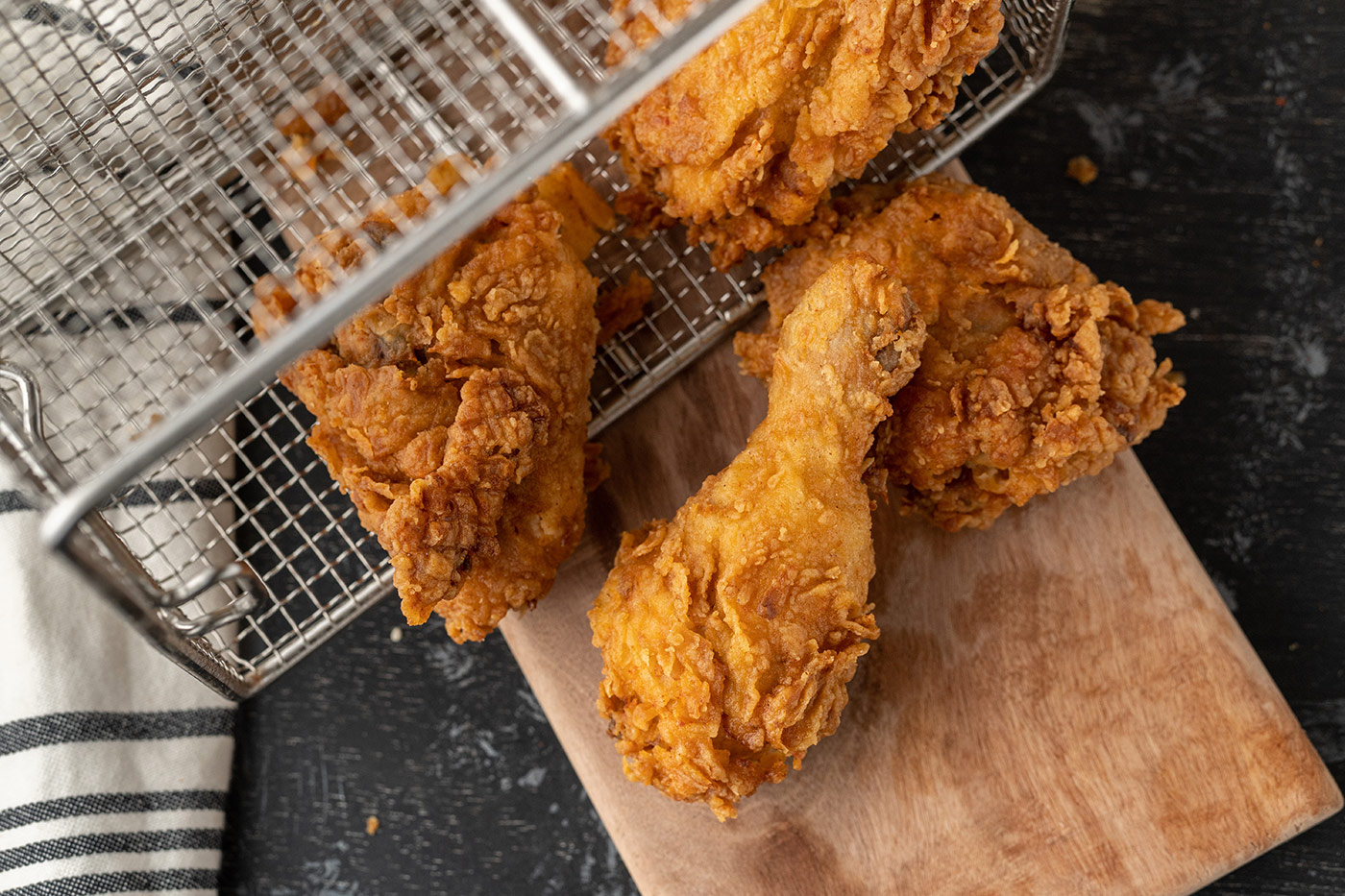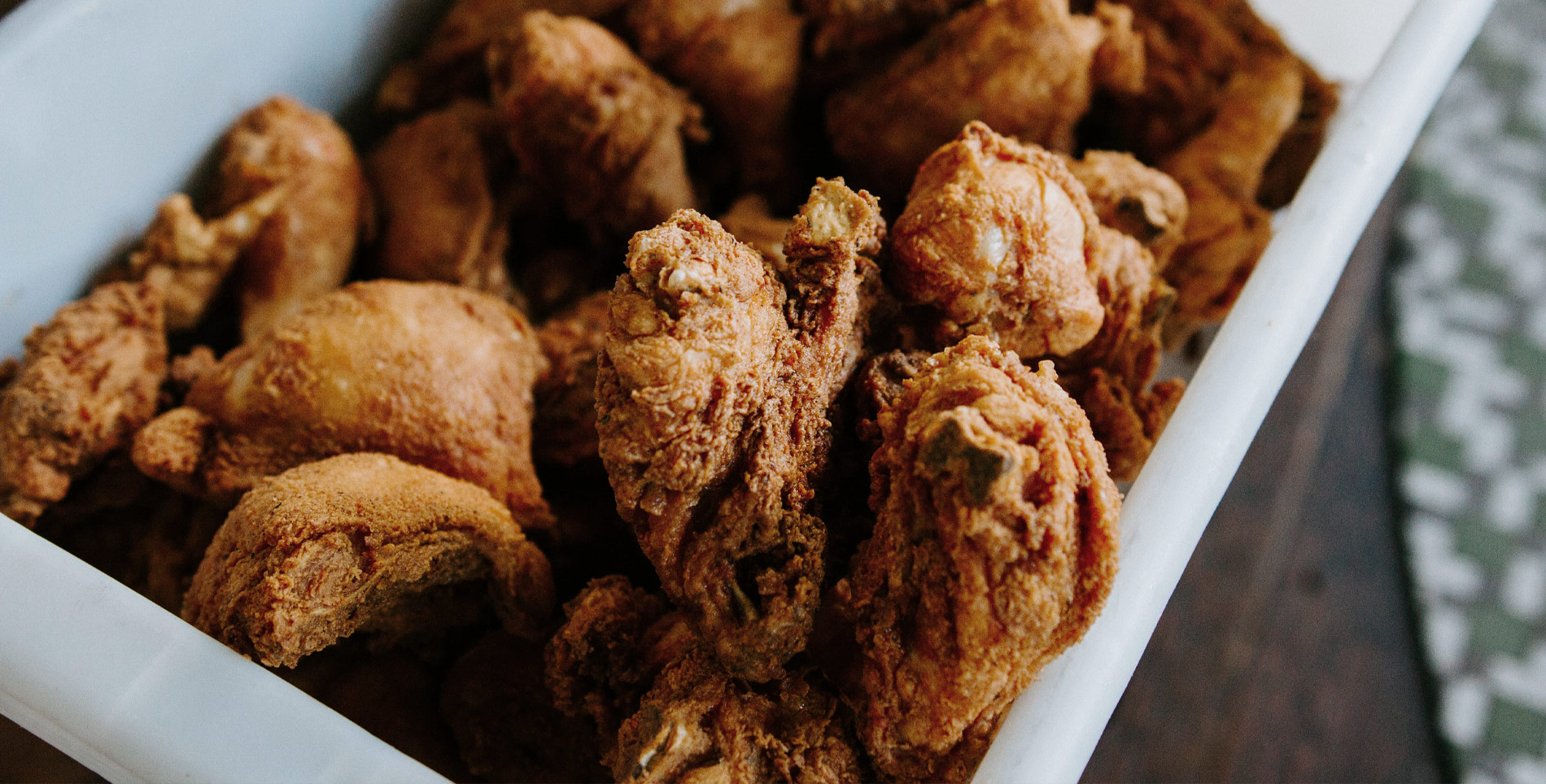Few dishes are as associated with the American South as the dearly beloved fried chicken. The poultry dish has taken on a life of its own across the nation. You might enjoy it in New York City’s historic Harlem neighborhood, where at Charles Pan-Fried Chicken Chef Charles Gabriel serves three pieces of his pan-fried chicken with cornbread and a side like mac and cheese, collard greens, okra or potato salad.
Or perhaps, during an excursion to the southern wetlands, you opt for the treasures found in Willie Mae’s Scotch House, where three pieces of white or dark meat (yes, you will be judged by your selection) are served alongside sides like brightly seasoned green beans served with rice or candied yams, or the Willie Mae Chicken Sandwich—a maddeningly large fried chicken breast slathered with housemade pickles, zesty slaw sauce, honey and purple cabbage gently nestled between two warm buns. Or maybe, the West Coast is a better fit for your travel style. Jeremy McBryde and Mark E. Walker of Comfort LA will take care of you with their bone-in or boneless fried chicken wings, or their “Big Sexy” fried chicken sandwich, which includes a juicy piece of chicken breast topped with mango slaw and served in a black brioche bun.
Wherever you enjoy a bite of the piping hot meat, fried chicken is a crucial component of Black American foodways. The flavorful, deeply seasoned, and richly battered bird is often accompanied by rich macaroni and cheese, porky collard greens, and buttery cornbread. Though often initially recognized by its place in the canon of America’s best foods, it’s also representative of Black economic growth in the United States.
“If you look at the historical roots of entrepreneurship of people of African descent, since they became enslaved people, [fried chicken] was one of the few things that one could multiply and sell,” says Babson College professor of history and foodways Frederick Douglass Opie. Opie, who says the economic benefits of fried chicken can be traced back to American slavery, says the sale of fried chicken was a form of freedom.
“It’s really a part of what I call African American subsistence of culinary freedom, that the fried chicken evolves out of entrepreneurship,” he says.

Enslaved Africans continued benefitting from an expensive and easy-to-feed source of meat. Some of the earliest American Southern cookbooks, including those by freed Black authors, illustrate the allegiance many Southerners felt toward fried chicken, and that allegiance has carried on well into the 21st century.
Yet, despite African Americans’ role in turning fried chicken into a staple of American food, the community is taunted rather than revered. Stereotypes abound, and for some African Amercans, even admitting to enjoying fried chicken can be a complex and fraught decision. Associate professor and chair of American studies at the University of Maryland Psyche Williams-Forson has considered this conundrum for years. Her book, Building Houses Out of Chicken Legs: Black Women, Food, and Power, outlines the cultural significance of fried chicken, as well as the economic power that emerged from fried chicken businesses in Black communities—particularly for the countless number of Black women in the kitchen preparing the dish.
“Folks have started businesses and literally moved their families from poverty to the middle class because of food,” Williams-Forson says.
In Williams-Forson’s book, she explores the historical conditions that led to stereotypes associated with Black food, and the faces in which Black people, particularly Black women, existed and thrived in spite of them. She recounts the significance of shoebox lunches, meals that often included a piece of fried chicken that Black Americans could enjoy in the safety of their cars while traveling through the Jim Crow South. Cooking fried chicken as a vehicle for social and economic empowerment, Williams-Forson says, has continued in modern lives of Black folks, as have the negative connotations associated with it.
“By virtue of what people think you look like, you’re subjected to whatever crazy stereotype is circulating at the moment,” she says. “You can be the most intelligent, the most brilliant, and you will get reduced to a stereotype.”
These stereotypes and reductive tropes have created a sometimes fraught relationship between Black Americans and fried chicken. One only looks at coded insults against Black Americans in power, old propaganda imagery blatantly portraying racist tropes and ideology, and ongoing attacks against Black foodways to see that the presence of fried chicken has been the source of debate and moral attacks against Black Americans for centuries.
The visual of Black people eating chicken in the outwardly racist and deeply influential film, The Birth of a Nation, gave white Americans imagery for their misconceptions and theories about Black culture and life. This demonization of fried chicken as unhealthy and representative of social and economic challenges within the community can be traced back to the United States’ enduring habit of vilifying staples of Black culture.
However, many Black business owners have refused to be reduced by racism, and instead exalt the dish at their homes and restaurants. At Houston’s award-winning restaurant, The Breakfast Klub, fried chicken is not only one of the restaurant’s offerings—it’s the dish by which they judge themselves.
“It is the anchor and the foundation upon which everything else is built on,” owner and restaurateur Marcus Davis says. “It is the thing that you have to have on your menu, and the thing that has to be good.”
At The Breakfast Klub, daily lines wrapped around the Downtown Houston establishment indicate that the chicken is indeed very good. Although the restaurant has a full breakfast and lunch menu, most people come to get a taste of their two signature dishes: katfish and grits, and wings and waffles. Surrounding a golden Belgian waffle dusted in powdered sugar are six tender and juicy wings. The restaurant remains tight-lipped about their recipe, but Davis says preparing fried chicken properly boils down to technique, and the use of tender love and care.
“I wanted to emulate my grandmother,” Davis says of his legendary chicken dish. “Why is it important to know the history attached to the dish? For the same reason it’s important to recognize that Little Richard is the architect of rock and roll. It’s important to know where this thing came from.”
Davis is surrounded by Black peers who have a similar respect for fried chicken. There are thousands of fried chicken joints around the country, from family-owned mainstays like Hall’s Honey-Fried Chicken in Dallas, Texas, to major chains (which are largely white-owned) like KFC and Popeyes.
Fried chicken—served alone, with sides, in a sandwich, or in other new and creative ways—is more American than apple pie, thanks to the Black cooks who introduced the dish to American foodways. Williams-Forson says the key to fully enjoying fried chicken is understanding, celebrating and appreciating the Black American culture behind it.
“I think it’s important that we celebrate, but I also think it’s short-sighted to celebrate without pointing out the other side of this narrative, which gives rise to why we need to celebrate on some level,” she says. “It’s not just because we’re celebrating our innovation level. It’s also because if we don’t continue to remind people of our economic, social, political empowerment vis-à-vis foods, it is very likely that we will fall prey to the stereotypes by regurgitating them.”
Once people take a bite of a piece of well-seasoned, hot and tender fried chicken, according to Williams-Forson, it’ll be easier to remember.
“Go for the taste, but stay for the history.”







Our comments section is for members only.
Join today to gain exclusive access.